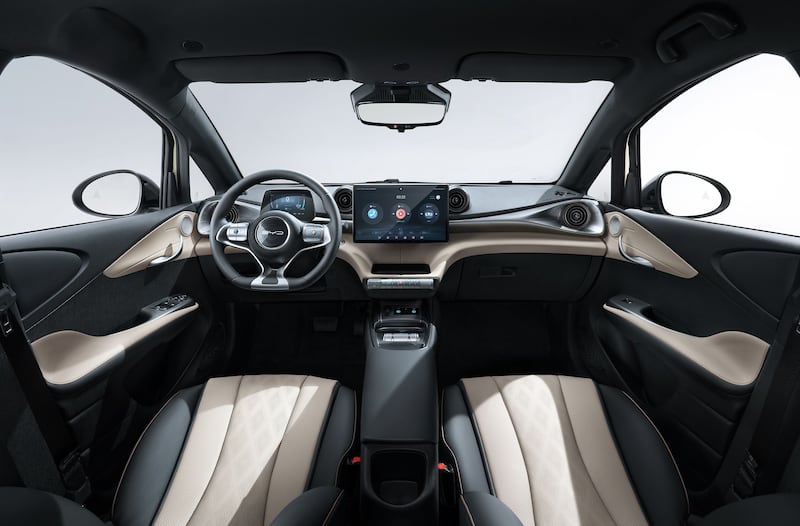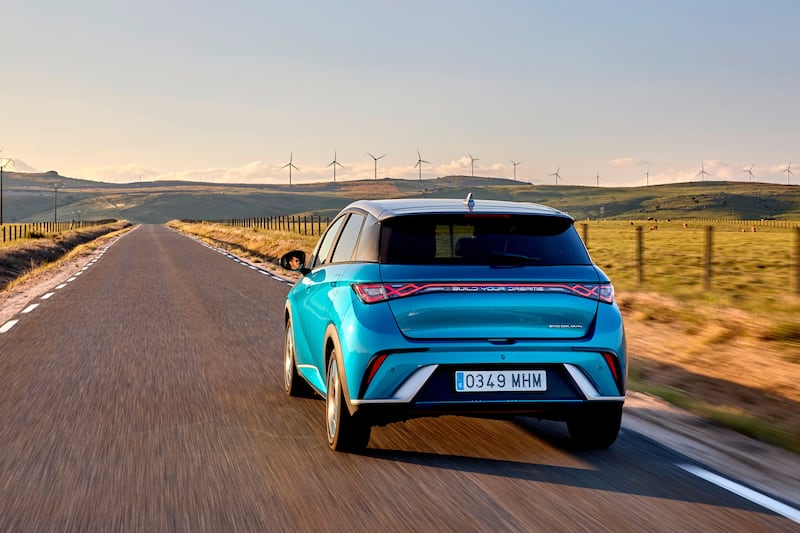Naming cars after animals is always a fraught process. After all, the Triumph Spitfire sounds like a great car until you realise that (a) it wasn’t, really and (b) it’s actually named after a famous aircraft, not the small Antarctic bird.
For every Ford Mustang (good name, although a Mustang is a type of horse rather than a specific animal) there’s a Nissan Bluebird. For each Plymouth Barracuda, there’s a Reliant Robin. See what I mean? There are potential trapdoors everywhere ...
What then are we to make of the BYD Dolphin? This mid-sized five-door hatchback is part of BYD’s “Ocean Series” of cars, in which all the models are named for aquatic animals. Hence, the impressive BYD Seal saloon – a Tesla Model 3 competitor – and the small, and incredibly cheap, BYD Seagull, a compact electric hatchback currently on sale only in China.
BYD is itself seemingly a company comfortably sailing close to the rocks of whimsy, as its name is an acronym of Build Your Dreams. On our Dolphin test car, that phrase is written out in full on the tailgate, but BYD is apparently going to stop doing this for its European-market cars, as the levels of cringe are just too high here.
Seán Moncrieff: Visiting from France, my daughter found Ireland hard to love
Donal Skehan on making a family home in Sutton: ‘I love things that have a story attached’
Give me a quiet quitter over a loud worker any day - there’s nothing worse
Beyond curry sauce and chicken balls: Chinese food in Dublin is at the top of its game
The Dolphin doesn’t look much like a dolphin, but perhaps that’s for the best. Dolphins (the watery ones, not the electric ones) are sleek and swift, and hugely intelligent (at least the ones David Attenborough films are) but their shape would not translate well to a road-going object, as Chinese rival Great Wall Motors’ efforts with its Ora brand seem to prove.
So, instead, the Dolphin looks pretty conventional on the outside. It’s slightly snub-nosed with its square headlights inset well away from the edges of the bodywork, but it’s enlivened by the deep green and contrasting silver two-tone paintwork of our test car, and the jewel-like detailing of the rear lights.

Inside, it’s considerably more interesting. There in the centre is the same 12.8-inch touchscreen, which rotates from portrait to landscape and back again, as you’ll find in the Seal and the strong-selling Atto 3 crossover. There’s the same neat three-spoke steering wheel, the same high-backed bucket seats with soft “pleather” upholstery. It’s all quite familiar, but here in the Dolphin it seems even more impressive.
Why? Partly because of the price tag – which currently starts at €29,318 inclusive of grants and rebates, but which is set to fall further to about €25,000 once the smaller-battery, 310km range model arrives in the next couple of months – but partly because BYD has clearly made an effort to make the Dolphin’s cabin feel welcoming.
Where there are cheaper grades of plastic, such as low down on the dashboard or on the doors, BYD has added a slightly rough texture, which at least makes the plastics look more visually appealing.
Elsewhere, everything you touch and look at, from the click-click function of the circular air vents to the soft-touch surfaces of the dashboard itself, are all top-drawer. The Dolphin might be one of the most affordable EVs on the market, but it sure doesn’t feel like it inside. It’s significantly higher in quality than its closest rival, the MG4, and pretty well on a par with the Volkswagen ID.3. Space in the back is very good, space in the boot is ... adequate.
Only the touchscreen lets the side down. Yes, the rotating thing is cool for five minutes, but once you learn that if you’re wearing polarised lenses you can’t actually see the screen in its upright position, you just leave it in landscape. There is Apple CarPlay connectivity, but the menu layout is too fiddly. To get from, say, the podcasts screen in CarPlay back to the air-conditioning menu requires you to press and swipe the screen no fewer than three times, which is kinda silly. Added to which, the driver’s instrument screen behind the wheel – which is hugely welcome from a safety point of view – looks cluttered and slightly cheap.
However, the Dolphin redeems itself with its battery. Just as there have been carmakers – and Honda is the best example here – who were at the top of their game when making engines, so BYD is a battery maker first, and a carmaker second. And it shows.

The Dolphin’s “Blade” battery, which is built in to the structure of the car to improve stiffness and crash performance, is a lithium-iron phosphate battery, or LFP. LFP batteries are simpler and cheaper to make than the more familiar lithium-ion batteries to which we are used, but while they’re less energy-dense for a given size, they are far more robust, meaning that you can fast-charge them, and charge to 100 per cent, to your heart’s content. No more pussyfooting around at 80 per cent for fear of a monster repair bill further down the line.
Fully charged, the Dolphin claims a range of up to 427km, and our car was showing 419 on a full battery. And it delivers that kind of range, too. If you’re pounding the motorway, then the range will likely slip to around 380km, but in more mixed driving – even with the air conditioning going – the Dolphin’s battery hits its claimed marks. Our average energy use hovered around the 19kWh/100km mark, which is a little high, but skewed by lots of motorway miles. In more mixed conditions, the Dolphin easily averaged 16kWh/100km.
The downside? It will only fast-charge at speeds of up to 88kW from a DC rapid charger, which is a touch on the slow side. It’s acceptable enough if you’re not a regular long-haul driver, though.
Performance is fine. The Dolphin, as with most rivals, uses a 150kW or 204hp electric motor, but this one drives the front wheels, whereas the rival MG and VW cars are rear-driven. It matters little, because the Dolphin is no handling champ. It’s fine, and feels entirely competent, but the MG seems more agile and nippy, with sweeter steering. The Dolphin counters with a cosseting ride quality, but it’s quite noisy at a cruise, with a good bit of wind and tyre roar. 100km/h comes up in a reasonably perky 7 seconds, but it never feels all that quick, subjectively.
Would that put you off? Or would the name be a barrier? Possibly; possibly not. And it’s only with time that BYD will find out if its watery naming strategy actually chimes with European buyers. Given the price tag and the hugely impressive battery performance, there’s every reason to think that it might. Or maybe BYD should just bung Chrysler a bunch of cash and ask for the rights to the Barracuda name.
Lowdown: BYD Dolphin Design
Power: 150kW e-motor developing 204hp and 310Nm of torque, powering the front wheels via a single-speed automatic transmission.
Electric consumption: 15.9kWh/100km (WLTP).
Electric range: 427km (WLTP)
0-100km/h: 7.0 sec.
CO2 emissions (annual motor tax): 0g/km (€120).
Price: €31,192 as tested, Dolphin starts from €29,318.
Our rating 4/5.
Verdict: The Dolphin’s performance is so impressive that it’s (wait for it) sure to make a big splash.











